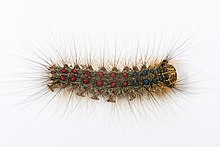Lymantria dispar
Lymantria dispar, renamed spongy moth in 2022,[1] formerly gypsy moth,[2][3] is a species of moth in the Erebidae family. It has subspecies, for example L. d. dispar and L. d. japonica. Lymantria dispar has become an introduced species. It is from Europe, Africa, and Asia, but humans brought it to North America and South America by accident. The larvae (caterpillars) can eat the leaves off broad-leaved and the needles off pine-like trees.[4] The catarpillars can damage trees and forests badly. Lymantria dispar is listed among the world's 100 most invasive alien species.
| Spongy moth | |
|---|---|

| |
| Mounted Lymantria dispar dispar male | |

| |
| Mounted Lymantria dispar dispar female | |
| Scientific classification | |
| Domain: | Eukaryota |
| Kingdom: | Animalia |
| Phylum: | Arthropoda |
| Class: | Insecta |
| Order: | Lepidoptera |
| Superfamily: | Noctuoidea |
| Family: | Erebidae |
| Genus: | Lymantria |
| Species: | L. dispar
|
| Binomial name | |
| Lymantria dispar | |
| Subspecies | |
|
L. d. dispar (European spongy moth) | |
| Synonyms | |
| |

Etymology
changeScientists call moths in the subfamily Lymantriinae "tussock moths" because of the tufts of hair on the caterpillars.[5]: 9
The name Lymantria dispar has composed of two words that both come from Latin. The genusc name Lymantria means "destroyer."[6] The species epithet dispar means "to separate" in Latin; it refers to the large differences between the male and female adult moths.[5]: 9 In some subspecies, the adult male can fly and the adult female cannot.
In July 2021 the Entomological Society of America, a group of scientists who study insects and other animals with skeletons on the inside decided to remove the name "gypsy moth" from its Common Names of Insects and Related Organisms List because it is "hurtful to the Romani people."[7][8] The Society looked at more than 200 names. They chose the new common name "spongy moth" because it matches names for the species in other languages. For example, in French, it is "spongieuse." The moth makes a sponge-like substance to put its eggs in.[2] The Society agreed to use the name in February. Every person on the committee voted yes.[1][3]
Taxonomy
changeScientists say the North American and European Lymantria dispar moths are the same subspecies, Lymantria dispar dispar.[9]: 6 But not all scienitsts agree. The U.S. Department of Agriculture says the Asian subspecies is any kind of L. dispar in which the female adult can fly[9]: 5 despite L. d. asiatica not being the only accepted subspecies that is capable of flight.[9]: 6 Traditionally, L. dispar has been referred to as "gypsy moth" even when referring to Japanese, Indian and Asiatic spongy moth populations.[9]: 5
Subspecies
change| Common name | Subspecies | Distribution | Identifying characteristics |
|---|---|---|---|
| European spongy moth | Lymantria dispar dispar | Europe, western Asia and north Africa,[9]: 6 introduced to Eastern North America | Females winged but flightless[9]: 6 |
| Asian spongy moth | Lymantria dispar asiatica | Eastern Asia,[9]: 6 introduced to western North America[10] | Females winged and capable of flight; attracted to lights[9]: 6 |
| Japanese spongy moth | Lymantria dispar japonica | All of Japan[9]: 6 | Large males, very dark brown color[9]: 6 |
The European subspecies (Lymantria dispar dispar) is native to forests in western Europe. It was introduced to the United States in 1869 and to Canada in 1912.
The Asian subspecies (Lymantria dispar asiatica) is native to Asia east of the Ural mountains. Since the early 1990s it has also reached the West Coast of North America. From southern Europe it is spreading north into Germany and other countries, where it mates with the European spongy moth, L. d. dispar.[source?] Someone found a colony of these animals in Great Britain in 1995.[source?]
Pest control measures
changeIn North America, the parasitoid encyrtid wasp Ooencyrtus kuvanae was introduced to kill the spongy moth. However, the wasp also attacks the eggs of other Lepidoptera species.[11][12]
Notes
changeReferences
change- ↑ 1.0 1.1 Sabrina Imbler (March 3, 2022). "Meet the Spongy Moth, Whose Old Name Contained an Offensive Term". New York Times. Retrieved March 3, 2022.
- ↑ 2.0 2.1 ""Spongy Moth" Proposed as New Common Name for Lymantria Dispar". entsoc.org. January 25, 2022.
- ↑ 3.0 3.1 "'Spongy Moth' Adopted as New Common Name for Lymantria dispar". Entomological Society of America. Retrieved 3 March 2022.
- ↑ FAO - Profiles of selected forest pests[permanent dead link]
- ↑ 5.0 5.1 The Gypsy Moth: Research Toward Integrated Pest Management, United States Department of Agriculture, 1981
- ↑ Free Dictionary for Lymantria
- ↑ "Entomological Society of America Discontinues Use of Gypsy Moth, Ant Names". Entomological Society of America. Retrieved 8 July 2021.
- ↑ Doubek, James (2021-07-10). "Insect Experts Will Change The Name Of The 'Gypsy Moth' And 'Gypsy Ant'". npr. Retrieved 2021-07-22.
- ↑ 9.00 9.01 9.02 9.03 9.04 9.05 9.06 9.07 9.08 9.09 Pogue, Michael. "A review of selected species of Lymantria Huber [1819]" (PDF). Forest Health Technology Enterprise Team. Retrieved September 14, 2012.
- ↑ "Asian Gypsy Moth Lymantria dispar asiatica". Pest Tracker National Agricultural Pest Information System. Retrieved September 14, 2012.
- ↑ Christenson, Amy (June 1997). "Know Your Friends". Midwest Biological Control News. Archived from the original on 26 November 2018.
- ↑ Brown, M. W. (1984). "Literature review of Ooencyrtus kuvanae [Hym.: Encyrtidae], an egg parasite of Lymantria dispar [Lep: Lymantriidae]". Entomophaga. 29 (3): 249–265. doi:10.1007/BF02372112. S2CID 867738.
Other websites
change- Media related to Lymantria dispar at Wikimedia Commons
- Spongy moth on UKmoths
- Bugguide.net
- Species Profile: European Gypsy Moth (Lymantria dispar) from the National Invasive Species Information Center, United States National Agricultural Library